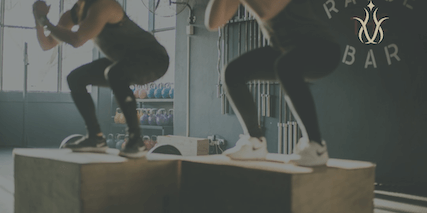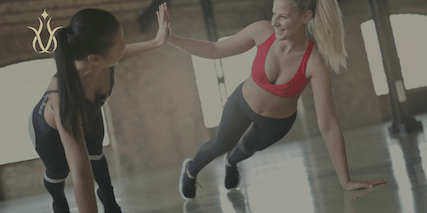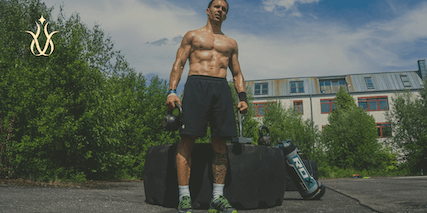
High-Intensity Interval Training (HIIT) is a popular workout methodology known for its efficiency in burning fat and improving cardiovascular health in a short period. The 30-minute HIIT workout is particularly appealing because it offers a compact, intense exercise session that fits easily into a busy schedule. This workout can be done with or without weights and can be adapted to various fitness levels.
Key Takeaways
- A 30-minute HIIT session can effectively burn calories and improve cardiovascular health.
- Dynamic warm-ups and cool-downs are crucial for safety and performance.
- HIIT workouts can be customized with weights or bodyweight exercises to suit individual fitness levels.
- Incorporating variety and proper intervals is key to maximizing the benefits of HIIT.
- Regular tracking of progress and setting realistic goals can enhance the effectiveness of your HIIT regimen.
Essential Warm-Up for HIIT

Dynamic Stretching
Dynamic stretching is crucial for preparing your muscles and joints for the intense activity ahead. Incorporate movements that mimic the workout itself, such as leg swings and arm circles, to ensure a thorough warm-up.
Cardio Prep
A light cardio session increases your heart rate and blood flow to muscles. Start with a slow walk or a gentle jog for 5-10 minutes, gradually increasing the intensity to prime your body for the HIIT session.
Mental Readiness
Prepare your mind as well as your body. Take a few minutes to clear your mind and focus on the workout goals. Visualization and setting a positive mindset can significantly enhance your performance and readiness.
Remember, a proper warm-up can significantly reduce the risk of injury and improve your overall workout effectiveness.
30-Minute HIIT Workout with Weights

Equipment Needed
To begin your 30 minute HIIT workout with weights, ensure you have the following equipment: dumbbells of various weights, a kettlebell, and a workout mat. Having the right equipment is crucial for an effective workout.
Exercise Sequence
This workout consists of a series of strength-based exercises designed to be performed in quick succession to maximize both cardiovascular and muscular endurance. Start with lower body exercises like squats, then move to upper body exercises such as overhead presses, and finally, do core exercises like Russian twists. Repeat the circuit three times with minimal rest between exercises to maintain a high heart rate.
Safety Tips
Always prioritize safety by ensuring proper form and technique during each exercise. Begin with lighter weights to assess your comfort and capability before progressing. Hydrate and take brief rests as needed to prevent injury and promote optimal performance.
Bodyweight HIIT Exercises

Benefits of Bodyweight Training
Bodyweight training offers a versatile way to improve fitness without the need for equipment. It’s ideal for those who prefer working out at home or have limited access to gym facilities. Bodyweight exercises can enhance strength, flexibility, and cardiovascular health, making them a comprehensive fitness solution.
Sample Workout Plan
A typical 30-minute HIIT bodyweight workout could include three rounds of exercises like squats, push-ups, and lunges, with short rest periods between each set. This routine effectively burns calories and improves cardio fitness. For a structured approach:
- Perform each exercise for 45 seconds
- Rest for 15 seconds between exercises
- Complete three rounds
Modifications for Beginners
Beginners should start with simpler versions of exercises and gradually increase the intensity. Modifications can include knee push-ups instead of standard push-ups or performing squats without a jump. Listening to your body and adjusting the workout to match your fitness level is crucial.
Maximizing Your Cardio Through HIIT

Understanding Cardio HIIT
To truly maximize your cardio through HIIT, it’s essential to grasp the core principles of high-intensity interval training. HIIT enhances cardiovascular health by significantly improving heart function, breathing, and reducing blood pressure. The key is to alternate between intense bursts of activity and fixed periods of less-intense activity or complete rest.
Integrating Intense Rounds
Integrating intense rounds effectively into your HIIT routine can dramatically increase your cardiovascular endurance. Start with shorter intense periods and gradually increase the duration as your fitness improves. To achieve optimal results, aim for 85-90% of your maximum exercise effort during these rounds.
Recovery Periods
Proper recovery periods are crucial in HIIT to prevent burnout and injuries. These intervals allow your heart rate to normalize and prepare your body for the next round of high intensity. Ensure your recovery periods are adequately timed to match the intensity of your workouts, providing a balanced approach to your HIIT sessions.
Cool Down Strategies Post-HIIT

Importance of Cooling Down
Properly cooling down after a HIIT session is crucial to optimizing recovery and preventing injuries. A cool-down helps gradually reduce your heart rate and can significantly decrease the likelihood of muscle stiffness. Spend at least 10 minutes on light cardio, such as walking, followed by five minutes dedicated to stretching the major muscle groups.
Stretching Exercises
Incorporate a variety of stretches to ensure all major muscle groups are adequately relaxed. Key stretches include the hamstring stretch, cobra pose, and downward dog. Each stretch should be held for about 30 seconds to effectively lengthen the muscles and enhance flexibility.
Hydration and Nutrition
Post-workout, it’s essential to rehydrate and refuel your body to aid in recovery. Drink plenty of water and consume a balanced meal with a good mix of carbohydrates and protein. This will help replenish energy stores and repair muscle tissues, making you ready for your next HIIT challenge.
Advanced HIIT Techniques

Increasing Intensity
To elevate the intensity of your HIIT workouts, focus on incorporating more complex movements and reducing rest intervals. Incorporate exercises that challenge multiple muscle groups simultaneously to maximize calorie burn and improve cardiovascular health.
Using Timers Effectively
Effective use of timers can significantly enhance your HIIT sessions. Set timers for both active periods and rest intervals to ensure precise timing, which is crucial for achieving the desired intensity and recovery balance.
Variety in Exercises
Adding a variety of exercises to your HIIT routine prevents plateauing and keeps the training engaging. Experiment with different modalities like weights, resistance bands, or bodyweight movements to keep your body guessing and continuously adapting.
Tracking Progress and Setting Goals

Measuring Success
To effectively track your fitness journey, it’s crucial to set measurable goals. This could range from increasing the weight you lift to improving your overall endurance. Utilize a fitness journal to record your workouts, noting the sets, reps, and weights used. This will help you see tangible progress over time and keep you motivated.
Adjusting Your Routine
As you progress, your body will adapt, necessitating changes in your routine to continue seeing improvements. Balance consistency and variety in your workouts to avoid plateaus. Adjust your exercise variations, rep schemes, or intensity every few weeks to challenge your body and further your gains.
Motivational Tips
Staying motivated can be challenging, especially when progress seems slow. Set short-term goals that lead to your main objective and celebrate these small victories. This will help maintain your motivation and commitment to your fitness goals. Remember, progress is a journey, and every step forward is an achievement worth recognizing.
Conclusion
Incorporating a 30-minute HIIT workout into your routine can significantly boost your fitness levels, burn calories, and improve cardiovascular health. Whether you choose to use weights, body weight, or simply focus on cardio, these intense sessions are designed to maximize your efforts in a short period. Remember to start with a proper warm-up and end with a cool down to prevent injuries. You can adjust the intensity and duration to suit your fitness goals as you progress. Consistency is key, so try to integrate these workouts into your weekly schedule for the best results.
Frequently Asked Questions
What are the benefits of a 30-minute HIIT workout?
A 30-minute HIIT workout is highly effective for burning calories, improving cardiovascular health, and enhancing metabolic rate. It’s a time-efficient way to exercise and can deliver significant fitness results in a shorter period.
Can I do a 30-minute HIIT workout every day?
Having rest days between HIIT sessions is generally recommended to allow your body to recover. Doing HIIT workouts every day can increase the risk of injury and burnout. Aim for 3-4 days a week for optimal results.
How many calories can I burn in a 30-minute HIIT session?
The number of calories burned can vary depending on the intensity of the workout and the individual’s body weight and fitness level. On average, you can burn around 290 calories in a 30-minute session.
Do I need special equipment for a 30-minute HIIT workout?
No, you do not necessarily need special equipment. Many HIIT workouts can be done using body weight alone. However, incorporating weights can increase the intensity and effectiveness of the workout.
What should I include in my warm-up before a HIIT session?
A proper warm-up should include dynamic stretching and light cardio exercises such as jumping jacks or brisk walking to prepare your muscles and cardiovascular system for the intense activity ahead.
How should I cool down after a HIIT workout?
A post-HIIT cool down should involve light stretching and low-intensity movements to help regulate blood flow and reduce muscle stiffness. Hydration and a nutritious post-workout meal can also aid recovery.
Related Articles
Top 10 Proven Exercises for a Flatter Stomach






